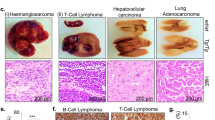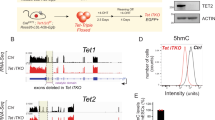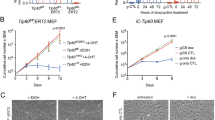Abstract
The transactivation/transformation–domain associated protein (TRRAP) belongs to the Ataxia-telangiectasia mutated (ATM) super-family and has been identified as a cofactor for c-MYC–mediated oncogenic transformation1,2,3. TRRAP and its yeast homolog (Tra1p) are components of histone acetyltransferase (HAT) complexes, SAGA (refs. 2,4,5), PCAF (ref. 3) and NuA4 (ref. 6), which are important for the regulation of transcription and cell cycle progression7,8 and also have a role in cell viability1,2. Yet the biological function of this molecule and how it controls proliferation are still unclear. Here we show that null mutation of Trrap in mice results in peri-implantation lethality due to a blocked proliferation of blastocysts. We use an inducible Cre-loxP system to show that loss of Trrap blocks cell proliferation because of aberrant mitotic exit accompanied by cytokinesis failure and endoreduplication. Trrap-deficient cells fail to sustain mitotic arrest despite chromosome missegregation and disrupted spindles, and display compromised cdk1 activity. Trrap is therefore essential for early development and required for the mitotic checkpoint and normal cell cycle progression.
This is a preview of subscription content, access via your institution
Access options
Subscribe to this journal
Receive 12 print issues and online access
$209.00 per year
only $17.42 per issue
Buy this article
- Purchase on Springer Link
- Instant access to full article PDF
Prices may be subject to local taxes which are calculated during checkout




Similar content being viewed by others
References
McMahon, S.B., Van Buskirk, H.A., Dugan, K.A., Copeland, T.D. & Cole, M.D. The novel ATM-related protein TRRAP is an essential cofactor for the c-Myc and E2F oncoproteins. Cell 94, 363–374 (1998).
Saleh, A. et al. Tra1p is a component of the yeast Ada.Spt transcriptional regulatory complexes. J. Biol. Chem. 273, 26559–26565 (1998).
Vassilev, A. et al. The 400 kDa subunit of the PCAF histone acetylase complex belongs to the ATM superfamily. Mol. Cell 2, 869–875 (1998).
Grant, P.A., Schieltz, D., Pray-Grant, M.G., Yates, J.R. & Workman, J.L. The ATM-related cofactor Tra1 is a component of the purified SAGA complex. Mol. Cell 2, 863–867 (1998).
McMahon, S.B., Wood, M.A. & Cole, M.D. The essential cofactor TRRAP recruits the histone acetyltransferase hGCN5 to c-Myc. Mol. Cell. Biol. 20, 556–562 (2000).
Allard, S. et al. NuA4, an essential transcription adaptor/histone H4 acetyltransferase complex containing Esa1p and the ATM-related cofactor Tra1p. EMBO J. 18, 5108–5119 (1999).
Brown, C.E., Lechner, T., Howe, L. & Workman, J.L. The many HATs of transcription coactivators. Trends Biochem. Sci. 25, 15–19 (2000).
Chen, H., Tini, M. & Evans, R.M. HATs on and beyond chromatin. Curr. Opin. Cell. Biol. 13, 218–224 (2001).
Metzger, D., Clifford, J., Chiba, H. & Chambon, P. Conditional site-specific recombination in mammalian cells using a ligand-dependent chimeric Cre recombinase. Proc. Natl. Acad. Sci. USA 92, 6991–6995 (1995).
Lanni, J.S. & Jacks, T. Characterization of the p53-dependent postmitotic checkpoint following spindle disruption. Mol. Cell. Biol. 18, 1055–1064 (1998).
Stewart, Z.A., Leach, S.D. & Pietenpol, J.A. p21(Waf1/Cip1) inhibition of cyclin E/Cdk2 activity prevents endoreduplication after mitotic spindle disruption. Mol. Cell. Biol. 19, 205–215 (1999).
Lengauer, C., Kinzler, K.W. & Vogelstein, B. Genetic instabilities in human cancers. Nature 396, 643–649 (1998).
Bunz, F. et al. Requirement for p53 and p21 to sustain G2 arrest after DNA damage. Science 282, 1497–1501 (1998).
Xu, W. et al. Loss of Gcn5l2 leads to increased apoptosis and mesodermal defects during mouse development. Nature Genet. 26, 229–232 (2000).
Yamauchi, T. et al. Distinct but overlapping roles of histone acetylase PCAF and of the closely related PCAF-B/GCN5 in mouse embryogenesis. Proc. Natl. Acad. Sci. USA 97, 11303–11306 (2000).
Nigg, E.A. Cell division mitotic kinases as regulators of cell division and its checkpoints. Nature Rev. Mol. Cell. Biol. 2, 21–32 (2001).
Morgan, D.O. Regulation of the APC and the exit from mitosis. Nature Cell Biol. 1, E47–53 (1999).
Dobles, M., Liberal, V., Scott, M.L., Benezra, R. & Sorger, P.K. Chromosome missegregation and apoptosis in mice lacking the mitotic checkpoint protein Mad2. Cell 101, 635–645 (2000).
Kalitsis, P., Earle, E., Fowler, K.J. & Choo KH. Bub3 gene disruption in mice reveals essential mitotic spindle checkpoint function during early embryogenesis. Genes Dev . 14, 2277–2282 (2000).
Hoyt, M.A., Totis, L. & Roberts, B.T.S. cerevisiae genes required for cell cycle arrest in response to loss of microtubule function. Cell 66, 507–517 (1991).
Cahill, D.P. et al. Mutations of mitotic checkpoint genes in human cancers. Nature 392, 300–303 (1998).
Michel, L.S. et al. MAD2 haplo-insufficiency causes premature anaphase and chromosome instability in mammalian cells. Nature 409, 355–359 (2001).
Waldman, T., Lengauer, C., Kinzler, K.W. & Vogelstein, B. Uncoupling of S phase and mitosis induced by anticancer agents in cells lacking p21. Nature 381, 713–716 (1996).
Cross, S.M. et al. p53-dependent mouse spindle checkpoint. Science 267, 1353–1356 (1995).
Di Leonardo, A. et al. DNA rereplication in the presence of mitotic spindle inhibitors in human and mouse fibroblasts lacking either p53 or pRb function. Cancer Res. 57, 1013–1019 (1997).
Krebs, J.E., Fry, C.J., Samuels, M.L. & Peterson, C.L. Global role for chromatin remodeling enzymes in mitotic gene expression. Cell 102, 587–598 (2000).
Megee, P.C., Morgan. B.A. & Smith, M.M. Histone H4 and the maintenance of genome integrity. Genes Dev . 9, 1716–1727 (1995).
Smith, E.R. et al. ESA1 is a histone acetyltransferase that is essential for growth in yeast. Proc. Natl. Acad. Sci. USA 95, 3561–3565 (1998).
Clarke A.S., Lowell, J.E., Jacobson, S.J. & Pillus, L. Esa1p is an essential histone acetyltransferase required for cell cycle progression. Mol. Cell. Biol . 19, 2515–2526 (1999).
Cliby, W.A. et al. Overexpression of a kinase-inactive ATR protein causes sensitivity to DNA-damaging agents and defects in cell cycle checkpoints. EMBO J. 17, 159–169 (1998).
Acknowledgements
We thank E.F. Wagner (IMP, Vienna, Austria) for kindly providing plasmids and reagents, and P. Chambon (Institut de Génétique et de Biologie Moléculaire et Cellulaire, Illkirch, France) for the pCre-ER plasmid. We also thank M.-P. Cros for the maintenance of mouse colonies and assistance in collecting blastocysts from Trrap mutant mice, W.-M. Tong for instruction on analysis of embryonic lethality, V. Petrilli for help in immortalization of MEFs and H. Li for preparation of kinase assays. We are also grateful to J. Bradbury, M. Glotzer, E. Passague, J.M. Peters, E. Van Dyck, and E.F. Wagner for critical comments and discussions. Further thanks are due to J. Cheney and E. El-Akroud for editing the manuscript. Work carried out in the laboratory of S.J. was funded by the Cancer Research Campaign.
Author information
Authors and Affiliations
Corresponding author
Rights and permissions
About this article
Cite this article
Herceg, Z., Hulla, W., Gell, D. et al. Disruption of Trrap causes early embryonic lethality and defects in cell cycle progression. Nat Genet 29, 206–211 (2001). https://doi.org/10.1038/ng725
Received:
Accepted:
Published:
Issue Date:
DOI: https://doi.org/10.1038/ng725
This article is cited by
-
Genomics of deletion 7 and 7q in myeloid neoplasm: from pathogenic culprits to potential synthetic lethal therapeutic targets
Leukemia (2023)
-
Conservation and diversity of the eukaryotic SAGA coactivator complex across kingdoms
Epigenetics & Chromatin (2021)
-
Structure of the human SAGA coactivator complex
Nature Structural & Molecular Biology (2021)
-
Involvement of the zebrafish trrap gene in craniofacial development
Scientific Reports (2021)
-
Chaperone-mediated ordered assembly of the SAGA and NuA4 transcription co-activator complexes in yeast
Nature Communications (2019)



